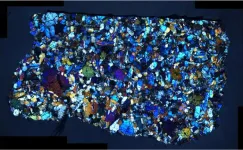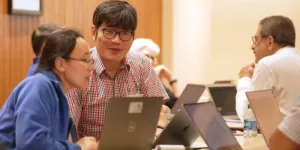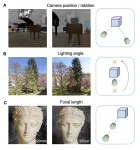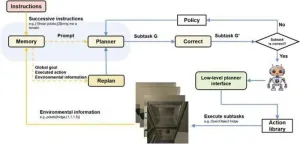(Press-News.org) A new, nano-scale look at how the SARS-CoV-2 virus replicates in cells may offer greater precision in drug development, a Stanford University team reports in Nature Communications. Using advanced microscopy techniques, the researchers produced what might be some of the most crisp images available of the virus’s RNA and replication structures, which they witnessed form spherical shapes around the nucleus of the infected cell.
“We have not seen COVID infecting cells at this high resolution and known what we are looking at before,” said Stanley Qi, Stanford associate professor of bioengineering in the Schools of Engineering and of Medicine and co-senior author of the paper. “Being able to know what you are looking at with this high resolution over time is fundamentally helpful to virology and future virus research, including antiviral drug development.”
Blinking RNA
The work illuminates molecular-scale details of the virus’ activity inside host cells. In order to spread, viruses essentially take over cells and transform them into virus-producing factories, complete with special replication organelles. Within this factory, the viral RNA needs to duplicate itself over and over until enough genetic material is gathered up to move out and infect new cells and start the process over again.
The Stanford scientists sought to reveal this replication step in the sharpest detail to date. To do so, they first labeled the viral RNA and replication-associated proteins with fluorescent molecules of different colors. But imaging glowing RNA alone would result in fuzzy blobs in a conventional microscope. So they added a chemical that temporarily suppresses the fluorescence. The molecules would then blink back on at random times, and only a few lit up at a time. That made it easier to pinpoint the flashes, revealing the locations of the individual molecules.
Using a setup that included lasers, powerful microscopes, and a camera snapping photos every 10 milliseconds, the researchers gathered snapshots of the blinking molecules. When they combined sets of these images, they were able to create finely detailed photos showing the viral RNA and replication structures in the cells. “We have highly sensitive and specific methods and also high resolution,” said Leonid Andronov, co-lead author and Stanford chemistry postdoctoral scholar. “You can see one viral molecule inside the cell.”
The resulting images, with a resolution of 10 nanometers, reveal what might be the most detailed view yet of how the virus replicates itself inside of a cell. The images show magenta RNA forming clumps around the nucleus of the cell, which accumulate into a large repeating pattern. “We are the first to find that viral genomic RNA forms distinct globular structures at high resolution,” said Mengting Han, co-lead author and Stanford bioengineering postdoctoral scholar.
The clusters help show how the virus evades the cell’s defenses, said W. E. Moerner, the paper’s co-senior author and Harry S. Mosher Professor of Chemistry in the School of Humanities and Sciences. “They’re collected together inside a membrane that sequesters them from the rest of the cell, so that they’re not attacked by the rest of the cell.”
Nanoscale drug testing
Compared to using an electron microscope, the new imaging technique can allow researchers to know with greater certainty where virus components are in a cell thanks to the blinking fluorescent labels. It also can provide nanoscale details of cell processes that are invisible in medical research conducted through biochemical assays. The conventional techniques “are completely different from these spatial recordings of where the objects actually are in the cell, down to this much higher resolution,” said Moerner. “We have an advantage based on the fluorescent labeling because we know where our light is coming from.”
Seeing exactly how the virus stages its infection holds promise for medicine. Observing how different viruses take over cells may help answer questions such as why some pathogens produce mild symptoms while others are life-threatening. The super-resolution microscopy can also benefit drug development. “This nanoscale structure of the replication organelles can provide some new therapeutic targets for us,” said Han. “We can use this method to screen different drugs and see its influence on the nanoscale structure.”
Indeed, that’s what the team plans to do. They will repeat the experiment and see how the viral structures shift in the presence of drugs like Paxlovid or remdesivir. If a candidate drug can suppress the viral replication step, that suggests the drug is effective at inhibiting the pathogen and making it easier for the host to fight the infection.
The researchers also plan to map all 29 proteins that make up SARS-CoV-2 and see what those proteins do across the span of an infection. “We hope that we will be prepared to really use these methods for the next challenge to quickly see what’s going on inside and better understand it,” said Qi.
Acknowledgements: Additional Stanford co-authors include postdoctoral scholar Yanyu Zhu, PhD student Ashwin Balaji, former PhD student Anish Roy, postdoctoral scholar Andrew Barentine, research specialist Puja Patel, and Jaishree Garhyan, director of the In Vitro Biosafety Level-3 Service Center. Moerner is also a member of Stanford Bio-X and the Wu Tsai Neurosciences Institute, and a faculty fellow of Sarafan ChEM-H. Qi is also a member of Bio-X, the Cardiovascular Institute, the Maternal & Child Health Research Institute (MCHRI), the Stanford Cancer Institute, and the Wu Tsai Neurosciences Institute, an institute scholar at Sarafan ChEM-H, and a Chan Zuckerberg Biohub – San Francisco Investigator.
This research was funded by the National Institute of General Medical Sciences of the National Institutes of Health. We also acknowledge use of the Stanford University Cell Sciences Imaging Core Facility.
END
A new way to see viruses in action
2024-05-31
ELSE PRESS RELEASES FROM THIS DATE:
Wealthier neighborhoods in Boulder saw lower bee diversity
2024-05-31
Community gardens in higher-income Boulder neighborhoods have fewer varieties of bees than their medium-income counterparts, new University of Colorado Boulder research suggests. Scientists suggest that people in these neighborhoods tend to apply more landscaping practices, such as using fertilizers, which could impact bees’ habitats.
The finding appeared May 22 in the journal Urban Ecosystems.
“Bees are so important for local ecosystems through their pollination services. The landscape would not look the same without our pollinators,” ...
Advancing excellence top priority for new board chair
2024-05-31
At its annual meeting on Thursday, the University of Miami Board of Trustees (BOT) confirmed Manuel “Manny” Kadre as its new chair, Wayne Chaplin and Bill Morrison as new vice chairs, and welcomed a slate of new trustees.
Kadre, chairman and chief executive officer of MBB Auto Group as well as a senior executive and shareholder of a number of beverage, automotive, health care, and real estate companies, first joined the board as a trustee in 2004. He served as a vice chair since June 2021 and more recently as board chair-elect.
“The University has one of the great reputations and brand names anywhere in the world,” ...
Martian meteorites deliver a trove of information on Red Planet’s structure
2024-05-31
Mars has a distinct structure in its mantle and crust with discernible reservoirs, and this is known thanks to meteorites that scientists at Scripps Institution of Oceanography at UC San Diego and colleagues have analyzed on Earth.
Meteorites that formed roughly 1.3 billion years ago and then ejected from Mars have been collected by scientists from sites in Antarctica and Africa in recent decades. Scripps Oceanography geologist James Day and his colleagues report May 31 in the journal Science Advances ...
Can ketones enhance cognitive function and protect brain networks?
2024-05-31
Researchers at the Del Monte Institute for Neuroscience at the University of Rochester have identified mechanisms in the brain’s hippocampal network that are rescued by ketones. These findings build on previous research showing that ketones can alleviate neurological and cognitive affects.
As we age our brain naturally becomes more insulin resistant. This creates a breakdown in communication between neurons, causing symptoms like changes in mood, cognitive decline, and eventually neurodegeneration. Nathan A. Smith, MS, PhD ('13), associate professor of Neuroscience, and fellow researchers studied the mechanisms in the brain that break down when insulin resistance is suddenly ...
AMS Science Preview: Sea-ice loss may accelerate; tornadoes and flying cars
2024-05-31
The American Meteorological Society continuously publishes research on climate, weather, and water in its 12 journals. Many of these articles are available for early online access–they are peer-reviewed, but not yet in their final published form.
Below is a selection of articles published early online recently. Some articles are open-access; to view others, members of the media can contact kpflaumer@ametsoc.org for press login credentials.
JOURNAL ARTICLES
Large-Scale Climate Modes Drive Low-Frequency Regional Arctic Sea Ice Variability
Journal of Climate
Arctic sea ice loss may accelerate in the coming decade. This study examined the dominant natural climate ...
UT Arlington, Microsoft host AI “Prompt-a-Thon”
2024-05-31
Faculty, staff and researchers from higher education and K-12 schools throughout Texas gathered in Arlington for the state’s first “Prompt-a-Thon” hosted by Microsoft and UTA’s offices of Research and Innovation and Information Technology. Together, educators and researchers learned how to best use artificial intelligence (AI) tools to improve their work.
“This Prompt-a-Thon is a significant step toward promoting AI literacy across multiple universities and establishing UTA as a frontrunner for AI use in the state,” said Jeremy Forsberg, associate ...
Children’s visual experience may hold key to better computer vision training
2024-05-31
UNIVERSITY PARK, Pa. — A novel, human-inspired approach to training artificial intelligence (AI) systems to identify objects and navigate their surroundings could set the stage for the development of more advanced AI systems to explore extreme environments or distant worlds, according to research from an interdisciplinary team at Penn State.
In the first two years of life, children experience a somewhat narrow set of objects and faces, but with many different viewpoints and under varying lighting conditions. Inspired by this developmental insight, the researchers introduced a new machine learning approach that uses information about spatial position to train AI visual ...
2024 Mahoney Life Sciences Prize goes to food scientist Lynne McLandsborough
2024-05-31
University of Massachusetts Amherst food scientist Lynne McLandsborough has won the 2024 Mahoney Life Sciences Prize for her research that offers a solution to a sticky sanitation and food safety dilemma hounding the peanut butter and chocolate industries.
“I was really surprised and excited,” McLandsborough says of winning the prize. “I think our research is innovative and there’s a need in the industry. It was a fun project.”
She is already in talks with Mars, the world’s ...
Ancient medicine blends with modern-day research in new tissue regeneration method
2024-05-31
For centuries, civilizations have used naturally occurring, inorganic materials for their perceived healing properties. Egyptians thought green copper ore helped eye inflammation, the Chinese used cinnabar for heartburn, and Native Americans used clay to reduce soreness and inflammation.
Flash forward to today, and researchers at Texas A&M University are still discovering ways that inorganic materials can be used for healing.
In two recently published articles, Dr. Akhilesh Gaharwar, a Tim and Amy Leach Endowed Professor in the Department of Biomedical Engineering, and Dr. Irtisha Singh, assistant professor in the Department of Cell Biology ...
Navigating new horizons: Pioneering AI framework enhances robot efficiency and planning
2024-05-31
In a groundbreaking study published in Cyborg Bionic Systems, researchers from Shanghai University have unveiled a new artificial intelligence framework that revolutionizes the way robots interpret and execute tasks. The "Correction and Planning with Memory Integration" (CPMI) framework leverages large language models (LLMs) to improve the efficiency and effectiveness of robots performing complex, instruction-based tasks.
Traditionally, robots required explicit programming and extensive data to navigate ...







